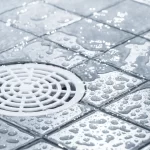Slow drains are a common household issue that many people tend to overlook. While it might seem like a minor inconvenience, a slow drain can be a sign of more significant underlying problems. Ignoring these issues can lead to severe consequences, including costly repairs, water damage, and health hazards. In this blog post, we’ll explore the hidden problems associated with slow drains, why you shouldn’t ignore them, and practical fixes to keep your plumbing system in top shape.
The Hidden Problems Behind Slow Drains
1. Partial Clogs
One of the most common causes of slow drains is partial clogs. These clogs are typically composed of hair, soap scum, food particles, grease, and other debris that accumulate over time. While water can still pass through, the flow is significantly reduced, leading to slow drainage. If left untreated, partial clogs can eventually become complete blockages, causing water to back up and potentially overflow.
2. Pipe Corrosion
Slow drains can also indicate pipe corrosion. Over time, metal pipes can corrode due to exposure to water and chemicals, leading to a buildup of rust and other debris inside the pipes. This buildup restricts water flow and can cause slow drainage. Corroded pipes are more prone to leaks and bursts, which can result in significant water damage and costly repairs.
3. Tree Root Intrusion
In some cases, slow drains can be caused by tree roots infiltrating the sewer lines. Tree roots naturally seek out moisture and can penetrate small cracks or joints in underground pipes. As the roots grow, they can create blockages that restrict water flow and cause slow drainage. This issue is particularly common in older homes with clay or cast-iron pipes.
4. Improper Pipe Installation
Improper pipe installation can lead to slow drains. If pipes are not installed with the correct slope, water may not flow efficiently, causing slow drainage. Additionally, poorly connected pipes can create areas where debris accumulates, leading to clogs and slow drains.
5. Ventilation Issues
Plumbing systems rely on proper ventilation to maintain air pressure and allow water to flow smoothly. If the vent pipes are blocked or damaged, it can disrupt the air pressure balance and cause slow drainage. Ventilation issues can also lead to unpleasant odors and gurgling sounds in the drains.
The Risks of Ignoring Slow Drains
1. Water Damage
Ignoring slow drains can lead to water damage. When water cannot flow freely through the pipes, it can back up and overflow, causing damage to floors, walls, and ceilings. Water damage can also lead to mold growth, which poses health risks and requires expensive remediation.
2. Health Hazards
Slow drains can create an environment conducive to mold and bacteria growth. Standing water in sinks, tubs, and showers can harbor harmful microorganisms that pose health risks to you and your family. Additionally, slow drains can produce unpleasant odors that affect indoor air quality.
3. Increased Repair Costs
Addressing slow drains early can prevent more severe plumbing issues and reduce repair costs. Ignoring the problem can lead to complete blockages, pipe bursts, and extensive water damage, all of which require costly repairs. Regular maintenance and prompt attention to slow drains can save you money in the long run.
4. Reduced Plumbing Efficiency
Slow drains can reduce the overall efficiency of your plumbing system. When water cannot flow freely, it puts additional strain on the pipes and fixtures, leading to increased wear and tear. This can shorten the lifespan of your plumbing system and necessitate more frequent repairs and replacements.
Practical Fixes for Slow Drains
1. Clean the Stopper
The stopper in your sink or tub can collect hair, soap scum, and other debris, leading to slow drainage. Remove the stopper and clean it thoroughly to remove any buildup. This simple step can often resolve slow drain issues without the need for chemical drain cleaners.
2. Use a Plunger
A plunger can be an effective tool for dislodging minor clogs and restoring proper water flow. Ensure there is enough water in the sink or tub to cover the plunger’s cup, then create a tight seal and plunge vigorously. This can help break up the clog and improve drainage.
3. Try a Drain Snake
A drain snake, also known as a plumber’s auger, is a flexible tool that can reach deep into the pipes to remove clogs. Insert the snake into the drain and rotate it to break up and remove the blockage. This method is particularly effective for removing hair and other debris that may be causing slow drainage.
4. Use Baking Soda and Vinegar
A natural and eco-friendly solution for slow drains is a mixture of baking soda and vinegar. Pour half a cup of baking soda into the drain, followed by half a cup of vinegar. The chemical reaction will help break down the clog. After 15 minutes, flush the drain with boiling water to clear any remaining debris.
5. Inspect and Clean the P-Trap
The P-trap is a U-shaped pipe located under the sink that can collect debris and cause slow drainage. Place a bucket under the P-trap to catch any water, then remove the trap and clean it thoroughly. Reassemble the trap and check for improved drainage1.
6. Check for Ventilation Issues
Ensure that your plumbing vents are not blocked or damaged. Inspect the vent pipes on your roof and remove any debris or obstructions. If you suspect a more serious ventilation issue, consider consulting a professional plumber for a thorough inspection and repair.
7. Professional Inspection and Maintenance
If you’ve tried the above methods and still experience slow drains, it may be time to call a professional plumber. A plumber can perform a thorough inspection of your plumbing system, identify the root cause of the problem, and recommend appropriate solutions. Regular professional maintenance can also help prevent future issues and keep your plumbing system in optimal condition.
Slow drains are more than just a minor inconvenience; they can be a sign of hidden problems that require prompt attention. By addressing slow drains early, you can prevent more severe plumbing issues, reduce repair costs, and maintain a healthy and efficient plumbing system. If you’re experiencing slow drains or need assistance with plumbing maintenance, our professional team is here to help. Contact us today to schedule an inspection and ensure your plumbing system is in top shape.
Additional Resources:
- Learn more about fixing slow drains (Bob Vila)
- Common plumbing problems you shouldn’t ignore (HomeAlliance)
- Why you should never ignore a slow drain (True Plumbing)
- How to fix a slow sink drain (The Spruce)
- Slow bathroom drains (Handyman Connection)






